U.S. Department of Transportation
Federal Highway Administration
1200 New Jersey Avenue, SE
Washington, DC 20590
202-366-4000
Federal Highway Administration Research and Technology
Coordinating, Developing, and Delivering Highway Transportation Innovations
| TECHBRIEF |
| This techbrief is an archived publication and may contain dated technical, contact, and link information |
| Publication Number: FHWA-HRT-14-074 Date: October 2014 |
Publication Number: FHWA-HRT-14-074 Date: October 2014 |
PDF files can be viewed with the Acrobat® Reader®
FHWA Publication No.: HRT-14-074 |
This document is a technical summary of the unpublished Federal Highway Administration report Development of Phased Array Ultrasonic Testing (PAUT) Acceptability Criteria (Phase I), available through the National Technical Information Service at www.ntis.gov.
The past decade has seen new, emerging innovations in the field of ultrasonic testing (UT). Specifically, multiple manufacturers have been producing phased-array ultrasonic testing (PAUT) systems. The PAUT system embeds a matrix of multiple (some up to 128) single transducers into one probe used for scanning objects. Exciting multiple transducers simultaneously offers distinct advantages; depending on the sequencing of transducer excitation, the ultrasonic beam could be steered within the material, and multiple beams help develop extra-dimensional data to assist with visualization of discontinuity size, shape, and location. Coupled with a linear encoder, PAUT data could also be digitally stored as a permanent record, something not possible for conventional UT.
Unfortunately, there has not been broad acceptance of PAUT in the bridge fabrication industry because it is currently not a recognized inspection technology in the American Welding Society’s (AWS) D1.5 bridge-welding code. One situation the technology would excel at would be inspection of complete joint penetration (CJP) butt welds. Currently, AWS D1.5 requires CJP welds subjected to tensile or reversal stresses to be inspected by radiographic testing (RT). However, discontinuities normally seen by RT should also be seen with PAUT. Until specification language is adopted into D1.5, there will continue to be hesitancy to use PAUT for the inspection of CJP butt welds, but acceptance criteria and the specification language must first be developed.
Phase I of this research effort involved a review of the current state of the art of weld inspection using PAUT, development of the preliminary technical approach to inspecting CJP butt welds with and without transitions, fabrication of suitable test specimens, and the use of appropriate calibration blocks for inspection of thick weld specimens. Based on a literature review, it was deemed necessary to first explore the phased-array pulse-echo (PE) technique for all inspections in this phase. The preliminary results from the inspections conducted on four butt-weld specimens are presented in this TechBrief. Phase II of the research will include development of scan plans for transition butt-welds. Indepth analysis of PAUT data obtained in phase I and phase II will determine the exact location and sizing information of the defects. Phase II will also compare PAUT results with those obtained using conventional UT and radiography. Phase III of this project will explore the time of flight diffraction and combined time of flight diffraction (TOFD)-PE approach. Phase I developmental efforts are presented in this TechBrief.
Weld inspections have been primarily carried out as part of quality control in manufacturing processes, mainly using radiography. Several research entities-including Electric Power Research Institute (EPRI), Naval Sea Systems Command, and the U.S. Army Corps of Engineers, among many others—have focused on improving the examination of welds using both ultrasonic and radiography techniques. Literature on the pros and cons of each technology has been frequently published. The comparisons indicate that radiography is well suited for detection of volumetric defects, but the issue of planar defects is of consequence, and ultrasonic inspections have been shown to address some of these issues. However, there is a lack of process qualification in using the ultrasonic technology, and several research groups are involved in understanding and developing the procedures to address these issues. EPRI has focused on developing guidelines for conducting nondestructive evaluations of dissimilar metal welds. A study carried out by the Federal Emergency Management Agency with specific focus on weld inspection technologies emphasizes the need for deviation from the current AWS D1.5 standards of acceptance criteria. Pacific Northwest National Lab, under contract to the Department of Energy (DOE),has carried out a study on the ultrasonic characterization of cast austenitic stainless steel microstructure. The gas and oil industry is heavily invested in research for inspection of pipelines for lack of fusion in the butt welds. DOE has also funded a study on the replacement of radiography with UT for nondestructive inspection of welds.
The American Society of Mechanical Engineers (ASME) boiler and pressure vessel code (BPVC) approves replacing radiography with UT, and the guidelines are provided in section XI of the ASME BPVC2. A similar approach to deviating from the current AWS D1.5 guidelines to incorporate PAUT is being pursued by several research groups.
An ultrasonic phased-array probe is composed of multiple elements, usually between 32 and 128, each of which can act as a single ultrasonic transducer. The patterns in which the elements may be arranged offer a variety of options, the simplest of which is a linear array. The ultrasonic wavefronts can be excited by pulsing the elements individually or as a group. The combination of these wavefronts generates the beam profile, which can be modified by varying the amplitude and timing of the excitation of each element. The focal laws are used to control of the amplitude and time delay for each element.
Three main electronic scanning techniques can control the beam profile. These scanning techniques, which use a linear pattern of the elements, are as follows:
Linear scanning. A subset or group of array elements is pulsed to form the desired beam profile. The focal law giving this beam profile is then electronically multiplexed along the length of the array. This is the electronic equivalent of mechanically scanning a conventional (single-crystal) probe along a distance equal to the length of the larger phasedarray probe. Currently, most commercially available arrays have up to 128 elements, which are typically pulsed in groups of 8 to 16.
Dynamic depth focusing. By varying the focal laws, the focal point is electronically moved with the additional angle of focus along the nominal beam axis.
Swept angular (sectorial or azimuthal)scanning. Selected focal laws electronically steer the beam along a fixed angle of incidence or sweep the beam through a wide angular range.
The PE technique uses a transducer to both transmit and receive the ultrasonic pulse, as shown in figure 1. The received ultrasonic pulses are separated by the time it takes the sound to reach the different surfaces from which it is reflected. The size (amplitude) of a reflection is related to the size of the reflecting surface. The PE ultrasonic response pattern is analyzed on the basis of signal amplitude and separation.
Defect sizing approaches often used in practice are based on the amplitude of the returned signal and its correlation with an equivalent machined reflector such as a notch or side-drilled hole. However, the correlation between defect size and amplitude is dependent on a number of variables, from the material, the equipment, and the defect itself. The material has potential velocity and microstructural variations, especially in steels; the equipment has potential amplitude variations depending on the type of pulser, frequency band, cabling, and other inherent electrical parameters. Ultrasonics are highly sensitive to defect orientation; roughness, curvature, and location also play roles. The size of the defect is directly related to the amplitude of the signal reflected. If the ultrasonic beam meets a reflecting surface, then part or all of the energy is reflected. The percentage of energy that is reflected is directly dependent on the size of the reflecting surface in relation to the size of the ultrasonic incident beam.
An important factor that influences the PE technique is that large defects are undersized, and small defects tend to be oversized. The oversizing of small defects is mainly owing to the fact that small defects act as omnidirectional emitters. Small defects emit anywhere inside the beam and thus are influenced by the beam spread. However, in the undersizing of large defects is more critical. In cases where the defect is curved, an inspection with a fixed-angle transducer beam leads to lower amplitude signals and size measurement.

Based on interactions with other federal agencies and experts in steel bridge fabrication, eight test specimens were fabricated. The specimens were manufactured by two steel bridge fabricators. The electro-slag welding (ESW) and submerged arc welding (SAW) processes were used to fabricate the specimens. The objective of using two welding processes was to determine the influence of the microstructure on the inspection technology. A brief overview of the two welding processes used to fabricate the specimens is described in the next section. These test specimens were developed in a controlled manner so as to implant defects that they typically encounter during their manufacturing process. The typical defects often found in welds are cracks, lack of fusion, lack of penetration, cavities, inclusions, excess penetration, undercut, concavity, burn-through, mismatch, and lamination. Each defect was implanted with intent to be separated from each other, and the defects could be surface or subsurface subsurface. The specimen thickness varied from 1 to 3.3 inches. The specimens were large and rectangular, requiring scanning lengths between 18 and 49 inches. The eight butt-weld specimens fabricated are listed in table 1.
| Table 1. Test specimens | |||||
| Specimen Designation |
Welding Process | Thickness (inches) | Length (inches) | Width (inches) | Fabricator |
|---|---|---|---|---|---|
| TP-2 | ESW | 1.5 | 28.0 | 24.5 | A |
| TP-3 | ESW | 3.3 | 22.0 | 23.5 | A |
| ESW-2-CP | ESW | 2.0 | 48.0 | 48.8 | B |
| TP-4 | SAW | 3.0 | 36.5 | 18.0 | A |
| TP-1 | SAW | 1.0‑2.0 | 26.5 | 25.0 | A |
| TP-5 | ESW | 1.5‑2.75 | 24.5 | 30.0 | A |
| ESW-1-2-CP | ESW | 1.0‑2.0 | 48.0 | 49.0 | B |
| GSAW-1-2-CP | SAW | 1.0‑2.0 | 48.0 | 48.0 | B |
SAW
SAW is an arc-welding process that fuses together the parts to be welded by heating them with an electric arc or arcs between a bare electrode or electrodes and the specimen. The arc is submerged under a blanket of granular flux. The filler metal is obtained by either melting the solid electrode wire or alloying elements in the flux. SAW can be used to join all weldable steels. The process provides high deposition rates that make it excellent for medium and thick sections of plate and pipe. Also, the process produces deep penetration, which means less edge preparation is required to obtain penetration. Full penetration welds are readily achieved on sections up to 0.47 inches thick without edge preparation. The process is normally limited to the flat and horizontal fillet positions because of the flux used to shield the weld puddle. However, with special flux dams, the process can be used in the horizontal groove weld position. Because the arc is hidden, only safety glasses are generally required by the welding operator. The process generally produces a smooth weld bead with no spatter. A layer of slag left on the weld bead is normally easy to remove.
Some of the side effects of SAW are the undercuts, highly narrow weld seam, and a large heat-affected zone (HAZ). At low currents, large droplets form on the electrode tip and get transferred to the weld pool through the slag at the periphery of the arc cavity. Too low a current will produce an unstable arc. The welding travel speed influences the weld size and penetration. High speed will result in undercuts, arc blow, porosity, and uneven bead shapes. The bead shape is essentially controlled by the welding speed. Too low a speed will produce heavy reinforcement and cause slag inclusions. The heat input rate (HIR) affects the microstructure of the weld metal and the HAZ. The higher the HIR, the lower is the cooling rate of the weld and the HAZ of the parent metal. Weld and HAZ microstructure and toughness will be dependent on the HIR.
SAW is sensitive to alignment of the electrode with respect to the joint. Misplaced beads can result from improper bead placement. The deep penetration of the SAW process can lead to center-line cracking due to improper width-to-depth ratios in the bead cross-sections.
ESW is a special automatic process normally used by the larger fabricators to butt-weld plates. It is a single-pass vertical process. ESW offers good productivity and quality in heavy structural fabrications. The weld metal in ESW process is obtained by fusing electrode wire under the blanket of flux layers. The heat for melting is obtained as resistance heat by passing current through the slag pool covering the complete surface of the weld metal. A pool of molten slag is formed between the edges of the parts to be welded and the traveling molding shoes. The metal electrode is then dipped into the molten slag, and the current passing through the electrode and the molten slag heats up the slag pool. The slag melting point is higher than those of the wire and the parent metal, so the electrode wire melts, and the molten metal settles at the bottom of the slag pool and solidifies to form the weld metal. To keep the welding stable, the slag pool must maintain its temperature. In ESW, the slag pool is 1.5–1.9 inches deep and offers a conductive path between the electrode and base metal. The current flow is therefore maintained after the arc is extinguished. In the case of SAW, which appears similar to ESW, the arc remains stable under the molten slag because the arc voltage is around 25–30 V, and the slag layer is rather shallow. Both non–consumable and consumable guides are used in ESW. Normally, defects like slag, inclusions, porosity, undercuts, and notches are not encountered in ESW.
In ESW, the weld metal stays molten long enough to permit slag– refining action, namely the escape of dissolved gases and transfer of non-metallic inclusions to the slag bath. The prolonged high temperature and the slow cooling rate in ESW result in a wide, coarsegrained HAZ having relatively soft high temperature transformation products. The weld itself has columnar cast structure. Therefore, the toughness of the weld and the HAZ will not be very high, and if the service condition does not require high toughness, the weld can be used. However, if the service condition requires high weld toughness, then proper normalizing heat treatment must be carried out so that all traces of cast structure are removed and toughness properties are improved.
Unfortunately, the high heat input and the long thermal cycle inherent in the process produce a large HAZ, which is subject to grain coarsening and a loss of fracture toughness. It is possible to improve the properties of an electro-slag weld joint by normalization or quenching and tempering; however, this is generally impractical due to the large size of the structures fabricated by ESW. When attempting to reduce the size of the HAZ, plate gap widths should be reduced as long as the form factor is kept within acceptable limits.
Two phased-array probes with center frequencies of 5 and 2.25 MHz were used for testing. The two frequencies were used to compare and contrast the effect of frequency on locating and sizing defects. The phased-array probes are linear-array type consisting of 16/64 elements. A nominal shear-wave refracted 60-degree wedge was used to ensure coverage of the weld and the HAZ. The following procedures ensure good calibration:
Typically, calibration blocks are made of the same material and heat-treated in the same fashion as the test specimen. Different types of reflectors, like side-drilled holes (SDH), flatbottomed holes (FBH), or notches, are used to calibrate phased-array examination. SDH is a widely used, well-defined, and reproducible reflector. Considering the thickness of our test specimens (up to 3.3 inches), a 2-inch-thick Phased Array Calibration Standard (PACSTM) block was used for velocity calibration, and a special calibration block for heavy walls was used for wedge delay and sensitivity calibration. The PACSTM block is made of 1018 steel consists of three radii (0.50, 1.00, and 2.00 inches). The block contains five holes at 3/64-inches diameter drilled through the 1.00-inch width, located at 0.10, 0.20, 0.40, 0.60, 0.80, 1.20, 1.40, 1.60, 1.80, and 1.90 inches from the respective scanning surface. It also includes an engraved scale from 30 to 70 degrees, associated with the 0.800-inch hole for beam angle verification. The block is 18 inches long, 2 inches high, and 1 inch wide.
The special–purpose, phased-array calibration block for heavy walls is made of 1018 steel and is 26 inches long, 6.5 inches high, and 1.25 inches wide. The block has ten SDHs that are 0.05 inches in diameter. All SDHs are parallel to the scanning surface. The calibration verification (carried out using the special block after performing all the checks and calibration steps) is shown in figure 2.

In the first phase of this work, scan plans were developed for four butt-weld specimens. The strategy in developing these scan plans was to take into consideration the detailed specific attributes of each specimen based on the thickness of the specimen, weld center line, and weld width. The scan plans were developed using the Eclipse Scientific BeamTool 5 software, which enables input of the specifics of the specimen as well as the technical specifications of the phased-array probe and the wedge used for inspections. The software provides a detailed ray path analysis based on the position of the probe and the sequence in which the elements are excited. Various combinations of the beam index points were used to determine the ideal location for probe placement. The scan plans demonstrate the various refracted angles to be used during the examination.
The complete coverage of the weld and the HAZ was an important aspect in developing the scan plans. The scan plan was to use the S-scans to optimize coverage to fully examine the weld and the HAZ. An unfocused sound beam was used to develop the approach.
Typically a single S-scan data point should provide complete coverage of the volume of the weld. However, in specimens that are significantly thick, as is the case with the test specimens in this research project, it is evident from the ray path simulations that it is necessary to use a minimum of two index points from both sides of the weld (at skew angles 90 and 270 degrees from weld centerline) as shown in figure 3 through figure 6 for specimen TP-3. This approach ensured full coverage in two crossing directions and provides complete weld volume coverage. In addition, inspecting opposite scanning surfaces using the same scan plan was deemed appropriate; this would validate the accuracy of the data from the first and second leg. Index points 1 and 3 provide coverage on the lower half of the weld with the first leg data, and index points 2 and 3 provide coverage of the top half of the weld with the second leg data. A similar approach was also used when inspecting the weld from the opposite scanning surface. Scanning from both sides of the plate provides additional data to infer statistically relevant conclusions in terms of locating and sizing defects. The various combinations of data acquisition based on the ray path analysis from different refracted angles and scanning from opposite sides of the weld and opposite scanning surface implies that the amplitude from defect signals also would vary. This approach provides additional data points to help determine the statistical accuracy in locating and detecting defects. Similar scan plans were developed for all the butt-weld specimens.
Data acquisition with the phased-array ultrasonic system was carried out using 5 and 2.25 MHz probes. Each of the test specimens was scanned. A combination of A-scans, B-scans, C-scans, and S-scans were used to interpret the data and determine the location of the defects. Volume-corrected C-scans were used as a first step in determining the approximate location of the defects, as shown in figure 7. The volume-corrected C-scan images further confirmed the need to use four index scanning points to ensure detection of all defects. Index points 1 and 2 are not able to discern the defect on the extreme right side of the scan as compared with the data from index points 3 and 4.
Based on the defect locations inferred from the volume-corrected C-scans, further analysis of the data will be carried out using a combination of S-scans and B-scans to accurately determine the location of each defect. An example of the sizing approach uses S-scan images to determine the height of the defects.




The defects that are located at the bottom of the weld specimen are located and sized using the first-leg data obtained from scan index points 1 and 3, as shown in figure 8. At the same time, the defects located on the top half of the test specimen are located and sized using the second-leg data obtained from scan index points 2 and 4, as shown in figure 9. The approach to length sizing using B-scan images is shown in figure 10. A combination of A-, B-,and S-scan images is used to determine the depth at which the defects occur. The ability to locate and size defects at different refracted angles, as shown in figure 11, also implies that the amplitude of the defect signal varies at each angle. This provides additional data points that could be statistically relevant in determining the accuracy of sizing the defects.
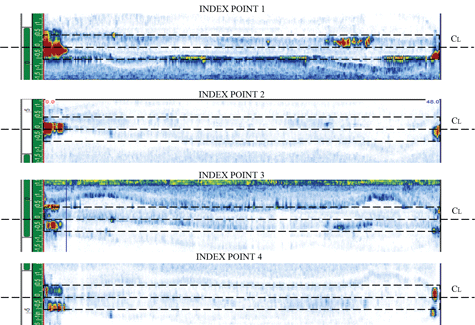
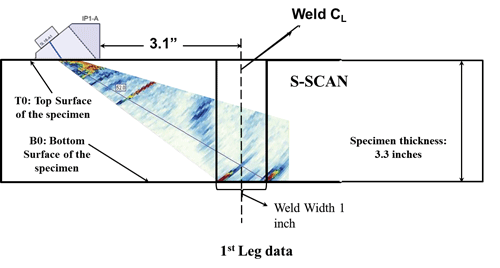
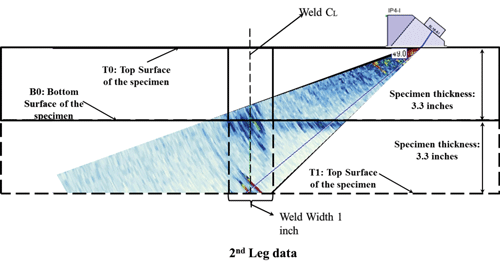
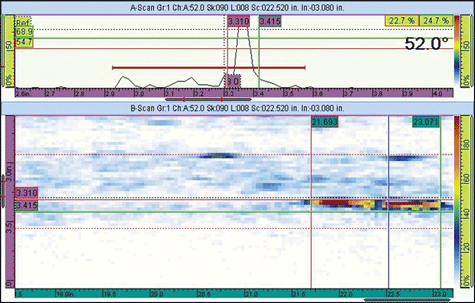
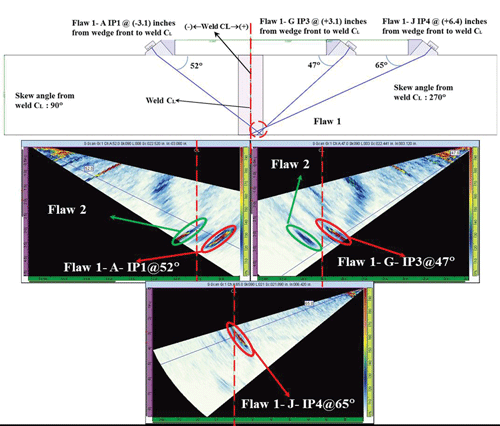
The preliminary technical approach and scan plans developed during phase I of this research were tested on four butt-weld specimens. The ray path analysis carried out when developing the scan plans and the preliminary data analysis indicated the need to carry out a minimum of two scans at different index points to enable complete volume coverage of the weld, particularly for thick weld specimens. The results also indicate the presence of defects (mainly lack of fusion, porosity, and cracks) in each of the four test specimens. The analysis of each defect to determine the size using the 6 dB drop method will be pursued in the phase II of this research, and the results will be compared with the quality assurance/quality control (conventional UT and radiography) results provided by the fabricators. Future work on developing similar scan plans for transition butt-welds and investigating TOFD and combined TOFD-PE approaches will be pursued in phase III of this research effort.
Ahmed, S. et al., Innovative Approaches to Automating QA/QC of Fuel Particle Production Using On-Line Nondestructive Methods for Higher Reliability, PNNL-15668, Pacific Northwest National Laboratory, Richland, WA, 2006.
Ciorau, P., "A Contribution to Phased Array Ultrasonic Inspection of Welds Part 1: Data Plotting for S- and B-Scan Displays," NDT.net, Vol. 12, No. 6, June 2007; Canadian Institute for Nondestructive Evaluation, Vol. 28 No. 5, pp. 7–10, September/October 2007.
EPRI Nondestructive Evaluation Center, Assessment of the Intergranular Stress Corrosion Cracking Training and Qualification Program: Interim Report, EPRI NP-5658, Project 1570-2, 1988.
Wooldridge, A.B., and Woodcock, G.S., "Reliability of Radiography for Detection of Planar Manufacturing Defects in Thick-Section Welds," Insight (UK), 39(3), pp.139-147, 1997.
Cataldo, G., and R. Legori, "Advanced Ultrasonic Techniques in Pipeline Girth Welds Examination," ASME Pressure Vessels and Piping, 456, pp. 49, 2003.
Lozev, M., Validation of Current Approaches for Girth Weld Defect Sizing Accuracy by Pulse-Echo, Time-Of-Flight Diffraction and Phased Array Mechanized Ultrasonic Testing Methods, EWI Project No. 45066CAP, 2002.
Ginzel, E., Thompson, R., and Ginzel, R., A Qualification Process for Phased-Array UT using DNV RP-F118 Guidelines, 2011.
White, P., Spencer, R., and Porter, N., Enhanced Defect Detection and Sizing Accuracy Using Matrix Phased Array Ultrasonic's Tools, EWI Field Trial Report, pp. 58, 2009.
|
Researchers–This study was initiated by Engineering and Software Consultants, Inc., Chantilly, VA, Contract No. DTFH61-08-D-000014. Distribution–The report covered in this TechBrief is being distributed through the National Technical Information Service at www.ntis.gov. Availability–This TechBrief may be obtained from the FHWA Product Distribution Center by email to report.center@dot.gov, fax to (814) 239-2156, phone to (814) 239-1160, or online at https://www.fhwa.dot.gov/research. Key Words–Corrosion, section loss, nondestructive evaluation, phased-array ultrasonic, pulsed radiography, steel bridge. Notice–This document is disseminated under the sponsorship of the U.S. Department of Transportation in the interest of information exchange. The U.S. Government assumes no liability for the use of the information contained in this document. The U.S. Government does not endorse products or manufacturers. Trademarks or manufacturers' names appear in this TechBrief only because they are considered essential to the objective of the document. Quality Assurance Statement–The Federal Highway Administration provides high-quality information to serve Government, industry, and the public in a manner that promotes public understanding. Standards and policies are used to ensure and maximize the quality, objectivity, utility, and integrity of its information. FHWA periodically reviews quality issues and adjusts its programs and processes to ensure continuous quality improvement. |